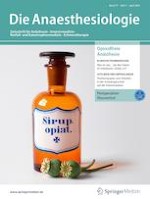Erschienen in:

03.04.2024 | Opioide | Leitthema
Opioidfreie Anästhesie
Irrweg oder sinnvoller Ausweg aus der Ära der opioidbasierten Analgesie?
verfasst von:
Julia Schiessler, Prof. Dr. med. Andreas Leffler
Erschienen in:
Die Anaesthesiologie
|
Ausgabe 4/2024
Einloggen, um Zugang zu erhalten
Zusammenfassung
In der Anästhesie sind zwar die Limitationen und Nachteile von Opioiden sehr gut bekannt, aber ihre Vorteile in Kombination mit dem Mangel an wirksamen Alternativen hindern bis heute daran, im Rahmen einer suffizienten Schmerztherapie auf Opioide zu verzichten. In der Schmerzforschung besteht seit Jahrzehnten das erklärte Ziel, Opioide durch neue Substanzen ohne ernsthafte Nebenwirkungen zu ersetzen. Aktuell scheint aber die Realisierung dieses Ziels in weiter Ferne zu liegen. Spätestens durch die mediale Berichterstattung über eine „Opioidkrise“ in Nordamerika wird die Einnahme von Opioiden zur Schmerztherapie auch von den Patient:innen zunehmend infrage gestellt. Maßnahmen zur Eindämmung dieser Krise greifen mit Blick auf immer höhere Todeszahlen nur langsam, aus diesem Grund wird nach wie vor ihr Auslöser gesucht. Die perioperative Verabreichung von Opioiden ist nicht nur ein möglicher Einstieg in eine Abhängigkeit und Missbrauch, sondern kann auch Outcome-relevante Komplikationen wie eine Atemdepression, postoperative Übelkeit und postoperatives Erbrechen sowie eine Verstärkung von postoperativen Schmerzen verursachen. Daher ist u. a. die Idee einer „opioidfreien Anästhesie“ (OFA) entstanden, d. h., es werden keine Opioide im Rahmen der Anästhesie zur Durchführung von operativen Eingriffen verabreicht. Wenn gleich dies auf den ersten Blick vielleicht sinnvoll erscheint, kann eine vorschnelle Einführung dieses Konzepts risikoreich sein, da dies erhebliche Veränderungen für das gesamte anästhesiologische Management mit sich bringt. Anhand einer relativ belastbaren Datenlage von klinischen Studien kann dieses Konzept mittlerweile nicht nur emotional, sondern auch sachlich bewertet und diskutiert werden. In diesem Übersichtsartikel werden Argumente für oder gegen den kompletten Verzicht auf intra- oder sogar perioperative Opioidgaben dargestellt. Berücksichtigt werden primär die aktuellen Bedingungen in Deutschland, damit eine perioperative Schmerztherapie auf die gesetzten Standards übertragbar ist. Für diese Darstellung werden Ergebnisse aus aktuellen klinischen Studien zur Umsetzung einer opioidfreien Anästhesie zusammengefasst und diskutiert.